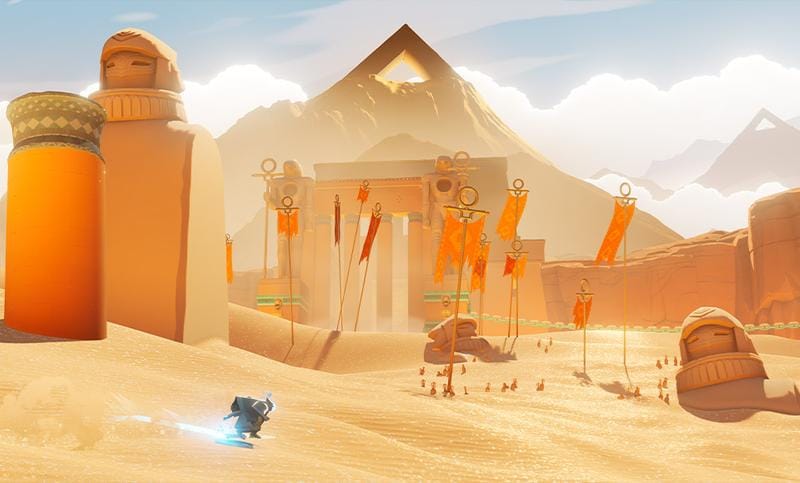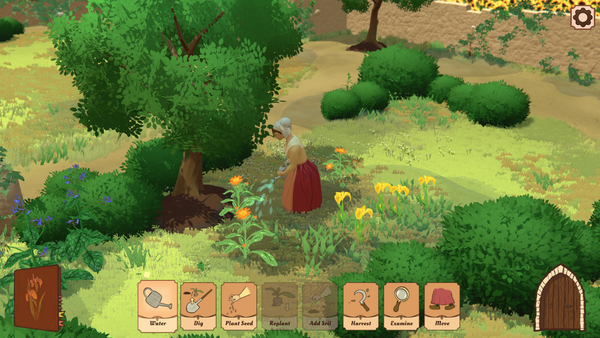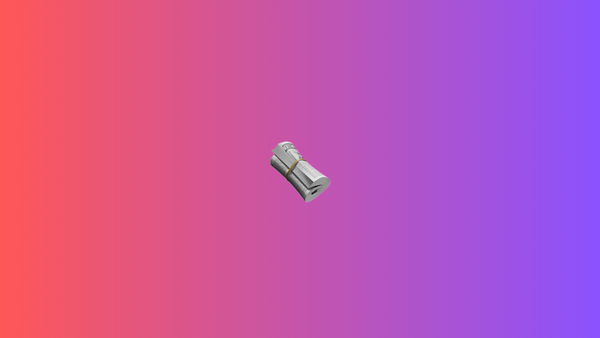Sword of the Sea is just another meditative exploration game
My first problem with Sword of the Sea is that every indie dev that made games like this was inspired by the monolithic Journey to make games that worked so much better for me. That’s not to say that Sword of the Sea didn’t work for me at all, but throughout my time playing the game, I found myself thinking of so many others in comparison than I probably should have. The visuals are gorgeous, the movement is pretty good, and the thematic core to the story resonates. I just think Jusant does it better.
Sword of the Sea is a meditative exploration game where you climb on your swordboard and hover-skate across roiling deserts and ancient ruins returning ocean life to the land of the gods. Each area is a vast space to explore with hidden tokens to find, animals to hang out with, platforming challenges to complete, and timed trick challenges to master. More on that later. Your little sword guy silently glided across the sand towards an unknown goal, visiting Monument Valley-esque temples and architecture. You’ll meet another masked figure throughout the levels and you’ll never believe what happens to them in the story (you will, you played Journey).
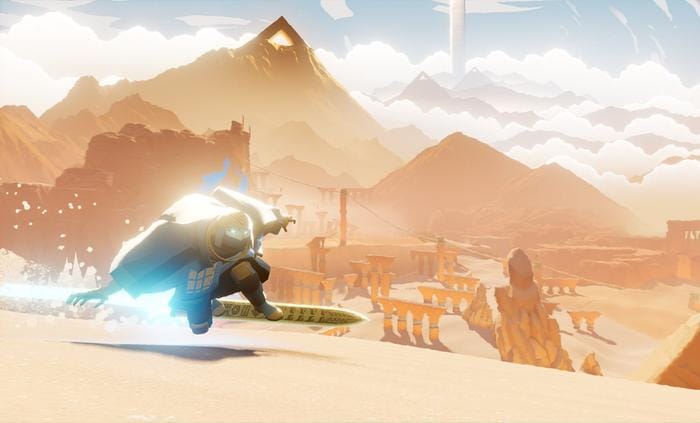
Navigating the undulating waves and crumbling villages is made pretty easy with a generous jump, a very forgiving grind mechanic, and well placed half-pipes and wall-rides. There’s no fail state and you’ll sometimes careen off a cliff, but no worries, you’ll be placed right on the edge you fell off to free-skate away again. Instead of collecting S-K-A-T-E, you’re exploring the environment to find hidden tiles that reward you with upgrade currency. Collect enough currency, then head to the merchant who will shake their jug and unlock tricks or other skills.
I’ll be upfront, I don’t like the trick system. It doesn’t feel tacked on—there’s plenty of trick variety—but it does feel unnecessary. So much of Sword of the Sea is about grand visuals and pulling the camera out to show it off, so pulling off a sick combo of LB+A into LB+Y is both distracting to the contemplative mood of the game and usually impossible to see. Even when you’re in the timed trick zones and the camera is close, I can barely tell the difference between the four different trick buttons. If you told me they were the same, I’d believe you.
You’re doing an air grab on a sword, that should mean something. It doesn’t.
Instead, it feels like the trick system exists to keep your hands busy while you glide across these beautiful settings. I know my attention span has cratered, but the system seems built to cater to our need to fidget, not serving a narrative or thematic point. In the emotional peak of the game when I should be crying, I’m still doing boost jumps into Christ Air Fakey Grab or whatever. The story you discover through poems and fables throughout the levels isn’t about finding joy in an everyday journey, it’s your classic battle between gods stuff. You’re doing an air grab on a sword, that should mean something. It doesn’t.
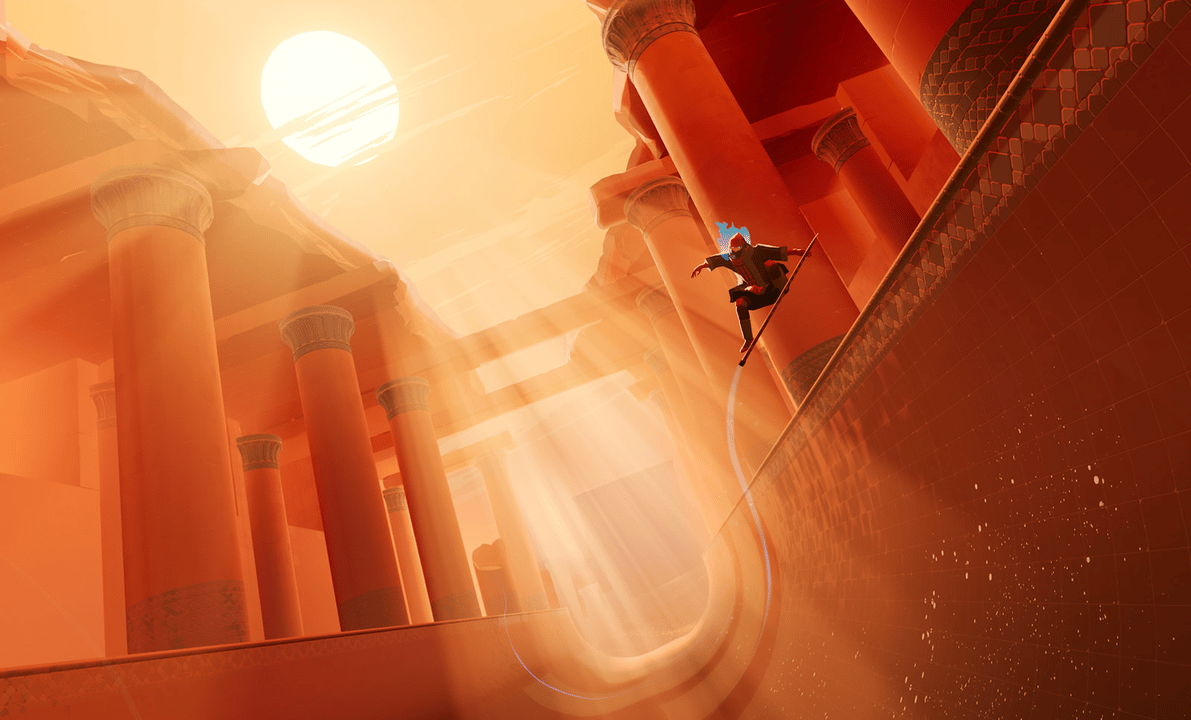
Sword of the Sea knows how distracting a trick system can be: there’s a hidden score counter and combo meter ticking up in the background that is only visible in the pause menu and after you hit credits. It’s smart because the game isn’t about doing tricks…except it is. There is a combo system that you can’t see on your first run (it appears on screen during new game plus), and, combined with the hard-to-read tricks, it’s impossible to know if I “land” a combo. Which again, is fine, but if I’m supposed to be getting good enough at the trick system to beat a timed challenge, the open zone should be great practice. Those timed challenges tend to be some of the best ways to make a ton of upgrade currency, which, at first, unlocks the trick system, and then some other traversal abilities. None of these upgrades are necessary to finish the game (and they’ll all unlock in new game plus), but each new ability fills the microseconds between platforming challenges and wordless cutscenes.
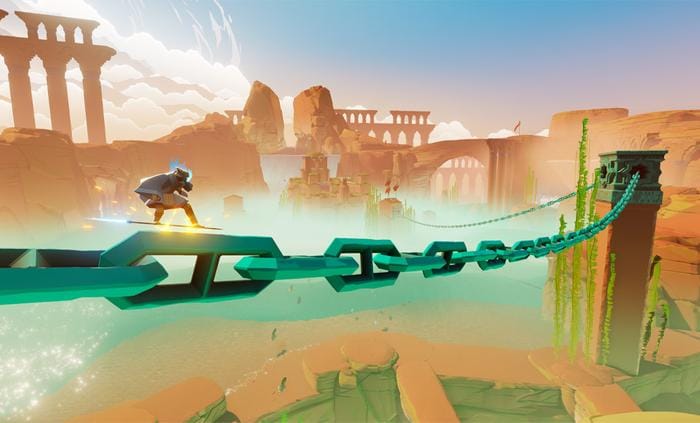
The general platforming is fun enough, and there are enough cute moments interacting with the animals or clever collectibles to find that I did plenty of exploring. But did I enjoy it? I really don’t know. I don’t ever feel disappointed when I jump on a jellyfish to find a treasure chest, but I don’t have a lot of excitement for collecting that currency to get what the next upgrade is. The platforming challenges aren’t difficult, and you can breeze through the game relatively quickly—it took me just over three hours to finish. I just wished for something more; more light puzzle solving, more momentary pauses on the incredible vistas, or more exploration of the themes the game really wants you to understand.

Sword of the Sea is a visual stunner, though. Sliding down an ocean slip-n-slide across undulating desert dunes is cool every single time it happens. Honestly, exploring the landscape for the sake of seeing what the team put on display is the best part of the game. There’s just so much to look at, both in the odd water effects with floating animals, and the surreal architecture to explore. Again though, I just wish there was more of it. After exploring the expansive desert in the first chapter, then finding an entire hidden village inside a mountain, I was a little disappointed to exit the village to find myself in another outdoor desert. There’s your classic ice level, lava level, and sad level.
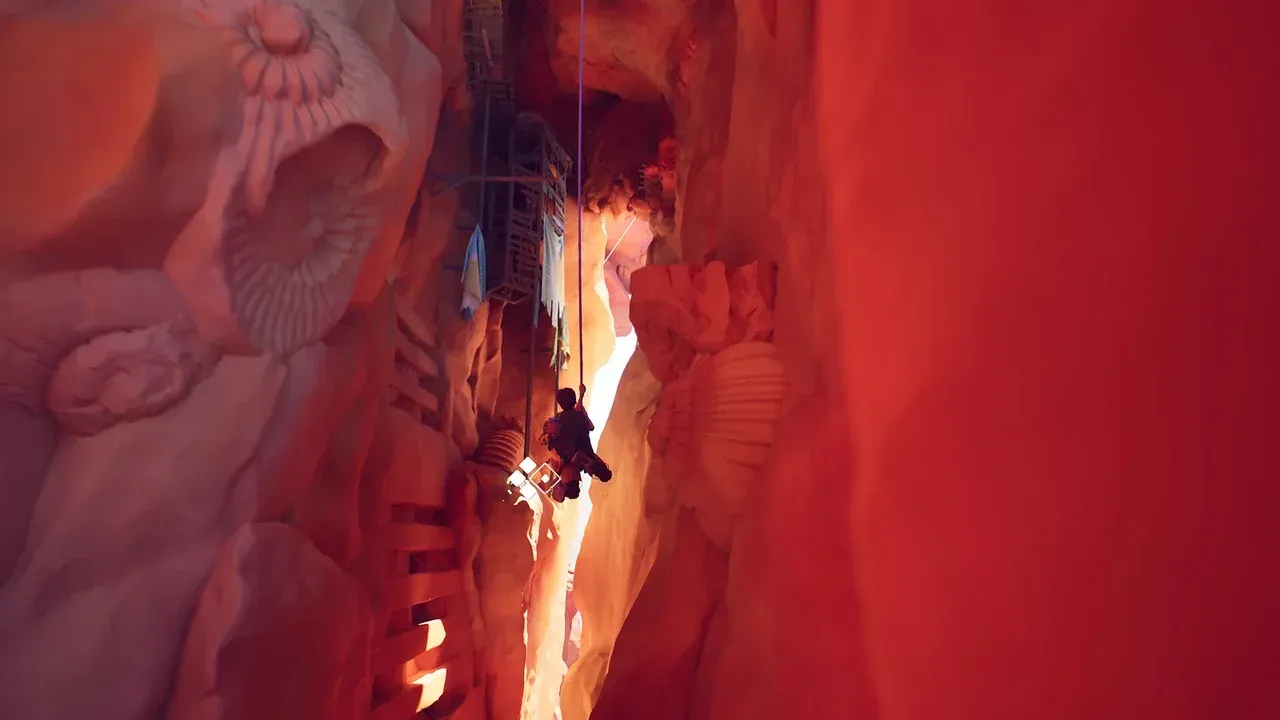
Playing Sword of the Sea, two games were stuck in my mind the entire time. The first is Jusant, a meditative climbing game from DON’T NOD that came out late 2023. In Jusant, you play a mostly silent protagonist who arrives at a water-forsaken pillar and begins to climb. Through 15 hours, you constantly climb upwards through weirder and more engaging environments, slight environmental changes—like wind or heat—impacting your climb. The story of Jusant involves the massive exodus of water from the pillar, but it’s more about the people and what they do when the water recedes. It’s about loss, fear, home, and community action in the face of immense tragedy. Everything about Jusant is minuscule in comparison to the pillar you climb, but that’s what makes it work.
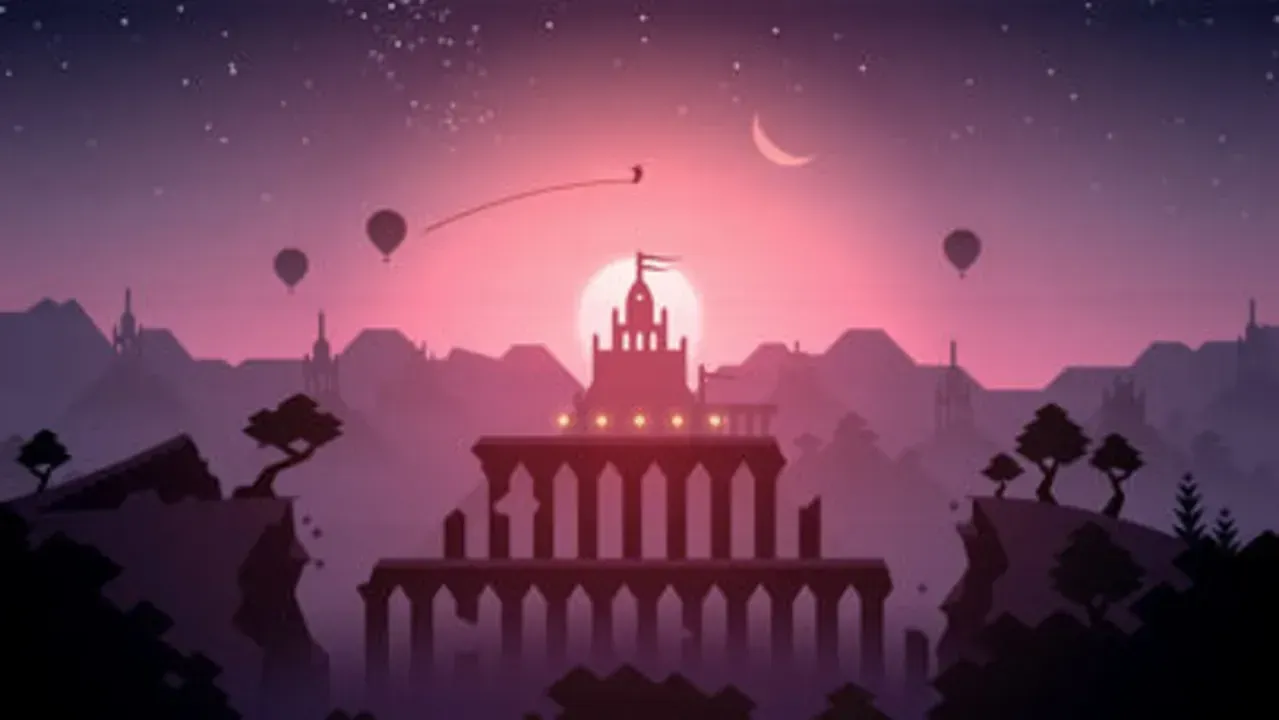
The other game was one my partner brought up having looked at the screen as I was gliding across the dunes: Alto’s Odyssey. A trio of meditative mobile sidescrollers, the Alto’s games are still in my top five all-time mobile games. You select a character with particular skills, then move from left to right on an infinite, procedural ski slope. You can jump, grind, and do backflips on your snowboard to build score, collect currency, and try to beat your last run’s length. The music is gorgeous and—especially Alto’s Odyssey and Lost City—evoke the same hidden kingdom in the sand that Sword of the Sea is going after. There is no story in the Alto’s games, instead there’s just incredibly tight traversal and trick systems that make bunnyhopping across the sand dunes and wall-riding endlessly enjoyable.
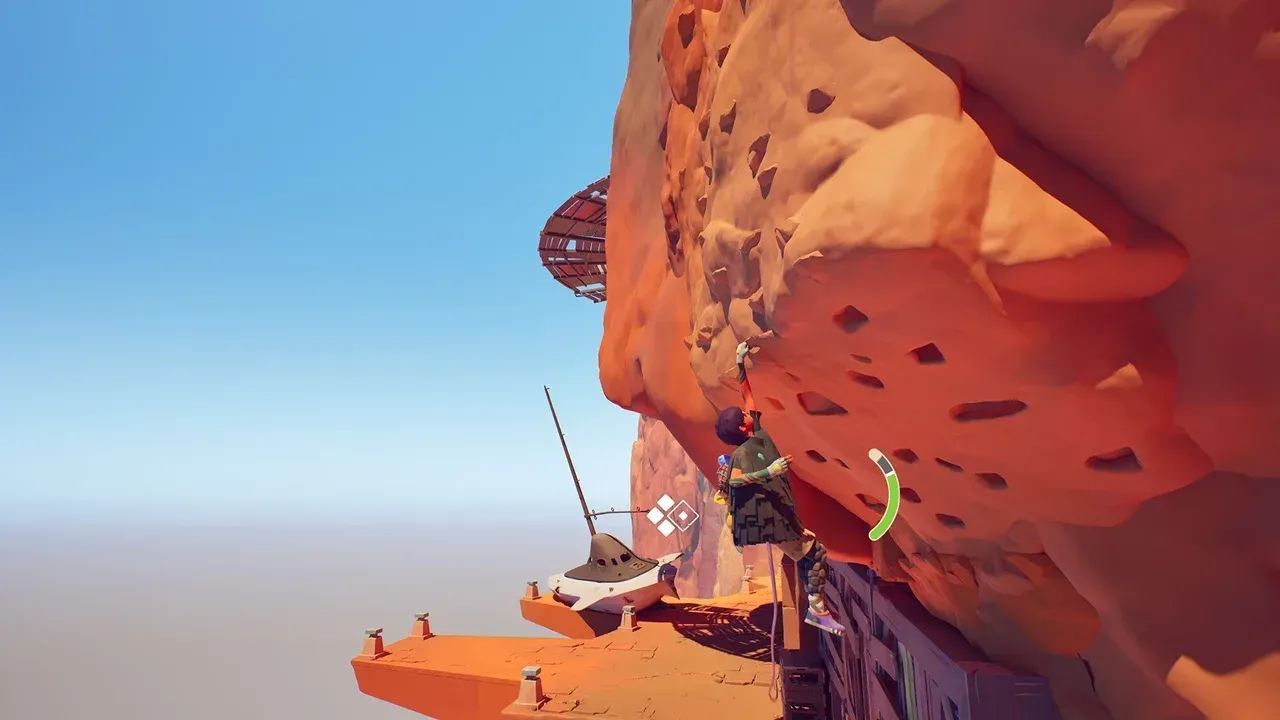
Jusant and the Alto games come to mind because it’s obvious to me how much these games are inspired by Journey and Abzu. They also come to mind because I think both games do what Sword of the Sea is trying to do better. The story of Sword of the Sea is about gods and greed, the clash of water and fire, written on hidden steles like a myth or fable that has a basic moral to it. Jusant is a game about personal perseverance and what small people do with big problems. Sword of the Sea has a convoluted and unnecessary trick system that detracts from traversal. The Alto games have a perfectly tuned mix of traversal and tricks, both designed to aid the other, not just pass time between points.
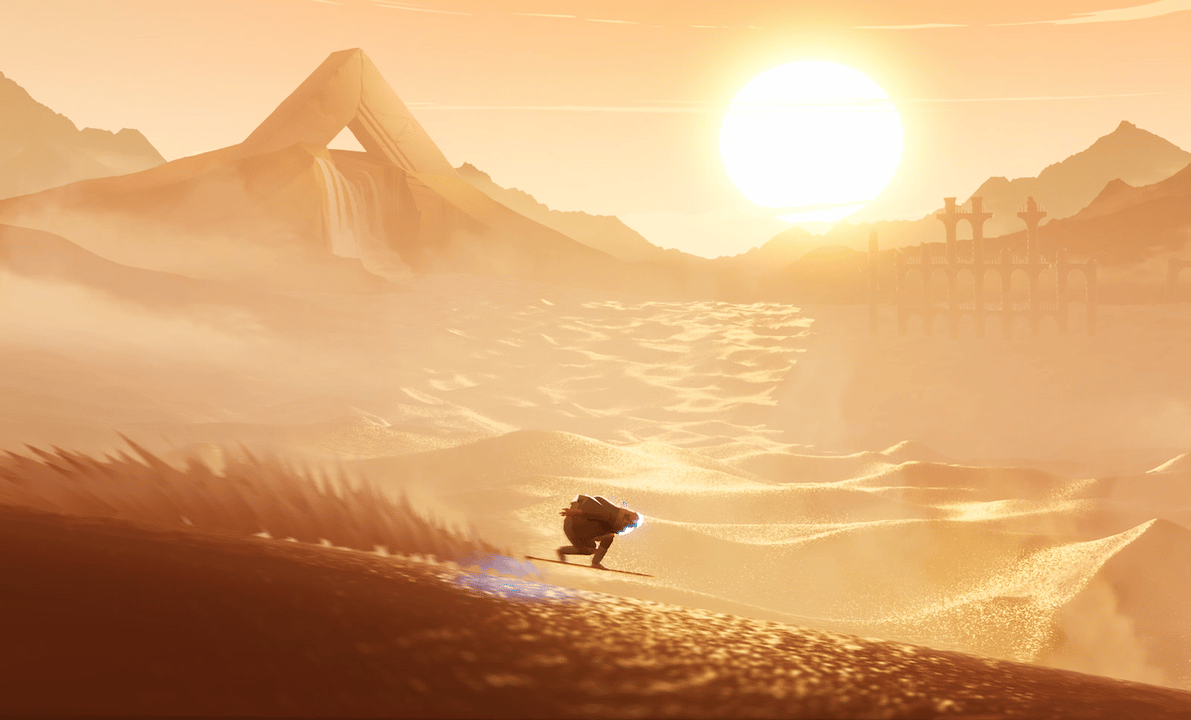
The genre—if you can call it that—of meditative Journey-likes has moved on from those humble roots, with new people bringing new perspectives to a game type that wowed so many when Journey first came out. But the team at Giant Squid (founded by some former members of thatgamecompany, the developer of Journey and Flower) is still making that game. I think you should still give Sword of the Sea a shot; it’s a breezy, fun game that I did end up enjoying. But when you’re done, I implore you: do a run or two in Alto’s Odyssey, and for god’s sake, play Jusant.


